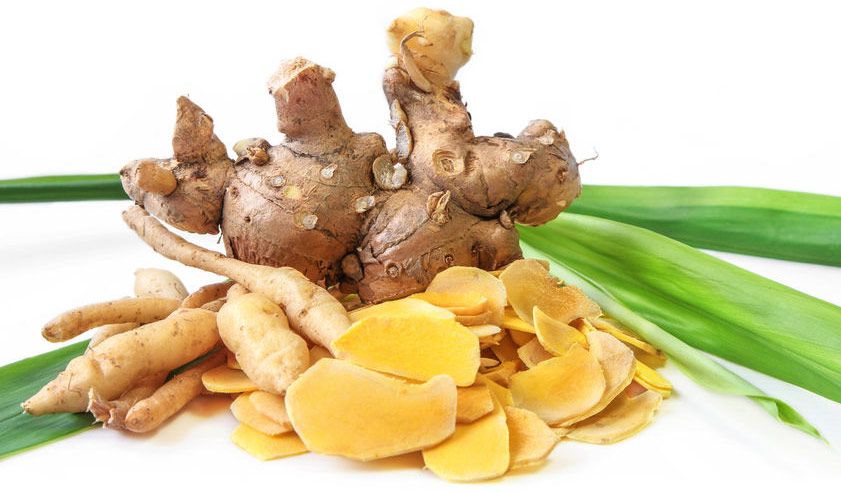Essential Oil of Plai (1)
- 8 April 2019

Adapted from White Lotus Aromatics Newsletter - Plai, Nov. 11, 2005 Compiled by Christopher Mahon reprinted with permission
http://www.whitelotusaromatics.com/
Some rural people residing in the villages of upper north-eastern Thailand still use herbs for preventing and curing many diseases. According to the interviews from traditional healers and elders living in seven villages in three provinces of Thailand, the medicinal plants are used in five ways – used as a rubbing or poultice, a decoction, an alcoholic tincture, a massage or eaten fresh.
Plai, Zingiber cassumunar Roxb., (SYN. Zingiber purpureum Roscoe), has long been regarded by Thai massage therapists as one of those oils necessary to have in their kit to combat joint and muscle problems. Plai is of the same family as ginger (Zingiber officinale Roscoe) but has different properties and more intense actions.
Native to Thailand, Indonesia and India, the pale amber oil is steam distilled from the fresh rhizome. It has a cool, green peppery aroma (not unlike Tea Tree) with a touch of bite. The main active chemical constituents of the oil are sabinene (27-34%), g-terpinene (6-8%), a-terpinene (4-5%), terpinen-4-ol (30-35%), and (E)-1-(3,4-dimethoxyphenyl)butadiene (DMPBD) (12-19%).
Considered analgesic, anti-neuralgic, anti-inflammatory, antiseptic, antispasmodic, antitoxic, anti-viral, carminative, diuretic, febrifugal, rubefacient and stimulating. Aromatherapeutic uses include aches and pains, asthma, catarrh, chronic colds, fevers, immune problems, inflammation, influenza, joint problems, muscle spasms, nausea, respiratory problems, sprains and strains, torn muscles and ligaments.
Proof for Plai
The essential oil exhibited a topical anti-inflammatory effect when tested. Individual assessment of the topical anti-inflammatory activity of the 5 major components of the oil demonstrated that DMPBD, terpinen-4-ol and a-terpinene significantly inhibited oedema formation, whereas sabinene and g-terpinene were inactive. The most active compound, DMPBD, was twice as potent as the reference drug Diclofenac (Voltaren).
Plai, while being of the ginger family, does not possess the classic heat that is common to the rhizomes. It has a cooling action on inflamed areas, be they joints and muscles or kidneys and lungs. Clients in Vancouver, Canada, have found that using Plai for asthma, with either tarragon (Artemisia dracunculus L.) or rosemary (Rosmarinus officinalis L.) and cypress (Cupressus sempervirens L.), causes the attacks to diminish greatly in intensity. The types of asthma thus far targeted have been exercise and allergy induced. Although clients report that the aroma is a little overwhelming at first, even just smelling the blend causes the attack to reduce. On inflamed joints, undiluted Plai has been found to ease pain for upwards of 18 hours, which is impressive when compared with other oils. On joints inflamed due to injury, Plai was best combined with oils such as black pepper (Piper nigrum L.) and lemon (Citrus limon (L.) Burm. f.) or neroli (Citrus aurantium L. ssp. amara L.), Himalayan cedarwood (Cedrus deodora G. Don. f.) and orange (Citrus aurantifolia Swingle). These combinations worked to take the swelling down, eased the pain and considerably speeded up the healing time. Used in a small rollette bottle, the 10% dilution in a vegetable oil is probably higher than that to which we are used in the UK. The oils were blended in equal parts.
For digestive upsets, Plai, together with black pepper, orange and tarragon, has been used to counter irritable bowel syndrome. This blend was applied across the abdomen and across the rectal tissue after each bowel movement or anytime there was any cramping or pain in the abdominal area. After three applications, all symptoms receded.
Plai extracts exhibited anti-inflammatory and anti-bacterial activities. A number of pure compounds isolated from the plants has been shown to possess anti-microbial, topical and oral anti-inflammatory, analgesic, smooth muscle relaxant, anti-tyrosinase and anti-oxidative activities. These therapeutic indications and the reported ethnomedical uses make Plai an attractive candidate for the development into cosmetics, spa and skin beautification products.
Selected References
Dechatiwongse T (1979) Preparation of Plai Ointment ( Zingiber cassumunar Roxb.) as a Mosquito Repellent. Bull. Dept. Med. Sci. 21(3), 187-92.
Kiatyingungsulee N et al. (1979) Some Pharmacological Studies of Active Constituent in Plai ( Zingiber cassumunar Roxb.). Bull. Dept. Med. Sci. 21(1), 13-25.
Amatayakul T et al. (1979) Chemistry and Crystal Structures of Some Constituents of Zingiber cassumunar Aust J Chem. 32, 71-88.
Ngearndee P et al. (1980) The Studies of Botanical and Pharmacognostical Structures on “ Plai” ( Zingiber cassumunar Roxb.). Bull Dept Med Sci 22(1), 187-92.
Tuchinda M et al. (1984) Study of Plai ( Zingiber cassumunar Roxb.) in Asthmatic Children. Siriraj Hosp Gaz 36(1), 1-5. Yongchaiyud P et al. (1985) Efficacy and Tolerance of Zingiber cassumunar Roxb. in Bronchial Asthma. Siriraj Hosp Gaz 37(6), 435-40.
Kanjanapothi D et al. (1987) A Uterine Relaxant Compound from Zingiber cassumunar. Planta Med 53(4), 329-32.
Ozaki Y, Kawahara N and Harada M (1991) Anti-inflammatory Effect of Zingiber cassumunar Roxb. and Its Active Principles. Chem Pharm Bull 39(9), 2353-6.
Taroeno, Brophy JJ and Zwaving JH (1991) Analysis of the Essential Oil of Zingiber cassumunar Roxb. from Indonesia. Flavour and Fragrance Journal 6, 161-3.
Pongprayoon U et al. (1996/97) Topical Anti-inflammatory Activity of The Major Lipophilic Constituents of The Rhizome of Zingiber cassumunar Part I: The Essential Oil. Phytomedicine 3(4), 319-22. Pongprayoon U et al. (1996/97) Topical Anti-inflammatory Activity of The Major Lipophilic Constituents of The Rhizome of Zingiber cassumunar Part II: Hexane Extractives. Phytomedicine 3(4), 323-6.
Giwanon R et al. (2000) Antimicrobial Activity of Terpinen-4-ol and Sabinene.
Thai J. Pharma. Sci. 24S, 27.
Reutrakul V (2002) Medicinal Value of Some Zingiberaceous Plants. The Journal of the Royal Institute of Thailand 27(4), 1165-72.
Research on Thai Aromatic Plants for Establishment of Essential Oil Database (2003), Thailand Institute of Scientific and Technological Research (TISTR), Bangkok, Thailand.
Jeenapomgsa R et al. (2003) Anti-inflammatory Activity of (E)-1-(3,4-dimethoxyphenyl)butadiene from Zingiber cassumunar Roxb. J Ethnopharm 87, 143-8.
